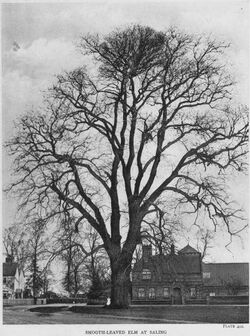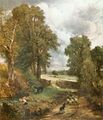Biology:Ulmus × hollandica
| Ulmus × hollandica | |
|---|---|

| |
| The Great Saling elm (1906), identified by R. H. Richens as U. × hollandica[1] (possibly older than the earliest named cultivar of this group in England, 'Dutch Elm') | |
| Scientific classification | |
| Kingdom: | Plantae |
| Clade: | Tracheophytes |
| Clade: | Angiosperms |
| Clade: | Eudicots |
| Clade: | Rosids |
| Order: | Rosales |
| Family: | Ulmaceae |
| Genus: | Ulmus |
| Species: | U. × hollandica
|
| Binomial name | |
| Ulmus × hollandica Mill.
| |
Ulmus × hollandica Mill. , often known simply as Dutch elm, is a natural hybrid between Wych elm (U. glabra) and field elm Ulmus minor which commonly occurs across Europe wherever the ranges of the parent species overlap. In England, according to the field-studies of R. H. Richens,[2] "The largest area [of hybridization] is a band extending across Essex from the Hertfordshire border to southern Suffolk. The next largest is in northern Bedfordshire and adjoining parts of Northamptonshire. Comparable zones occur in Picardy and Cotentin in northern France". Crosses between U. × hollandica and either of the parent species are also classified as U. × hollandica.[3] Ulmus × hollandica hybrids, natural and artificial, have been widely planted elsewhere.[1][4][5]
The botanical name hollandica was first used for an elm variety by Plukenet in 1697 in describing a cultivar of this group now called 'Major'.[6][7]
Description
In form and foliage, the trees are broadly intermediate between the two species.[8] F1 hybrids between wych and field elm are fully fertile, but produce widely variant progeny.[1] Many also inherit the suckering habit of their field elm parent.[9] Both Richens and Rackham noted that examples in the East Anglian hybridization zone were sometimes pendulous in form.[1][10]
Pests and diseases
Some examples of the hybrid possess a moderate resistance to Dutch elm disease.[11]
Cultivation
The hybrid has been introduced to North America and Australasia.
Notable trees
The great elm in The Grove of Magdalen College, Oxford, photographed by Henry Taunt in 1900,[12] long believed to be a wych elm before being identified by Elwes as a 'Vegeta'-type hybrid, was for a time the largest elm known in Britain before it was blown down in 1911. It measured 44 m tall, its trunk at breast height being 2.6 m in diameter,[13] and comprised an estimated 81 cubic metres (2,900 cu ft) of timber,[14] making it the largest tree of any kind in Britain and possibly the largest north of the Alps.[15] However, as Elwes pointed out, its calculated age would place its planting in the late 17th or early 18th century,[16] long before the introduction of the Huntingdon elm, making the tree in question more likely to be a Chichester elm. A second tree nearby, described by Elwes as "similar in habit and foliage" [17] and 130 feet (40 m) tall by 23 feet (7.0 m) in girth in 1912,[18] was confirmed by Nellie Bancroft in a Gardener's Chronicle article in 1934 as a 'Vegeta'-type hybrid;[19] it was propagated by Heybroek in 1958 and cultivated at the Baarn elm research institute as clone P41.[20][note 1] The tree survived till the 1960s. Like the Queens' College Chichester elms in Cambridge, the Magdalen College trees were not observed to produce root suckers, though The Grove at Magdalen has long been a deer park, and any sucker growth is likely to have been cropped.[16] The Oxford zoologist Robert Gunther attributed the larger tree's unusual size to the fact (discovered in 1926) that it had been growing on a phosphate-rich bone-bed, made up of the remains of mammoths and other prehistoric animals.[21]
The great elm in The Grove, Magdalen College, Oxford (ca. 1870)[22]
Magdalen College elm after being blown down (1911)[24]
With a girth of 6.9 m (22.6 ft) and a height of 40 metres (130 ft), the Ulmus × hollandica hybrid elm on Great Saling Green, Great Saling, near Braintree, Essex, reckoned at least 350 years old,[25] was reputedly the largest elm in England, before succumbing to Dutch Elm Disease in the 1980s;[26] Elwes and Henry (1913) misidentified it as U. nitens (Ulmus minor).[5]
Examples of mature survivors in the East Anglian hybridisation zone include those near Royston, Hertfordshire, designated 'Elm of the Year, 2004' by Das Ulmen Büro.[27] An example of the weeping form survives at Actons Farm, Sawbridgeworth, Hertfordshire.[28]
There are two notable TROBI Champion trees in the British Isles, one at Little Blakenham, Suffolk, measuring 160 centimetres (5.2 ft) d.b.h. in 2008, the other at Nounsley, Essex, 17 metres (56 ft) high by 150 centimetres (4.9 ft) d.b.h. in 2005.[29]
The so-called W. G. Grace Elm, a majestic spreading hybrid (labelled just "Dutch elm"), the last survivor (2009) of a ring of elms round East Oval, Ballarat, Victoria, was reputedly planted by W. G. Grace himself in 1874 during a tour by the England cricket team.[30] It has been shown, however, to date from 1900.[31] 'W. G. G.' had attained a spread round the middle of 31 m by 1982.[32]
Cultivars
At least 40 cultivars have been recorded, although some may not have survived Dutch elm disease: Others provisionally identified as Ulmus × hollandica include 'Scampstoniensis' and 'Virens (by Green); 'Purpurea' and 'Louis van Houtte' (by F. J. Fontaine); 'Escaillard' and 'Hillieri' (by Buisman); 'Rugosa Pendula' (by Arnold and Morton arboreta); and Späth's 'Fastigiata Glabra' (by Melville). Cultivars at one time or another identified as U. × hollandica, but which may have suffered misidentification through confusion with U. glabra Huds. cultivars that share the same name include 'Fastigiata Glabra', 'Fastigiata Macrophylla', 'Latifolia', and 'Rugosa'. In the 19th century and early 20th, Ulmus × hollandica cultivars (as well as those of wych elm) were often grouped under Ulmus montana.[13][33][34]
An unidentified U. × hollandica cultivar (not 'Vegeta') on Leith Links, Edinburgh (fruiting, April 2017)
In art
The elms in the Suffolk landscape-paintings and drawings of John Constable were "most probably East Anglian hybrid elms ... such as still grow in the same hedges" in Dedham Vale and East Bergholt.[35] (His Flatford Mill elms were U. minor.[36]) Elm trees in Old Hall Park, East Bergholt, showing a clump of these hybrids, is often considered the finest of Constable's elm-studies.[37][38]
John Constable, The Cornfield, 1826 (lane between East Bergholt and Dedham) [39]
John Constable, Elm trees in Old Hall Park, East Bergholt, 1817 (Ulmus × hollandica[37])
Accessions
North America
- Arnold Arboretum, US. Acc. nos. 325-81, 7614, 92-38
- Bartlett Tree Experts, US. Acc. nos. 1245, 1246
- New York Botanical Garden, US. Acc. no. 508/79
- Niagara Parks Botanical Gardens, US. Acc. no. 940414
Europe
- Sir Harold Hillier Gardens, UK. Acc. no. 1977.0615
- Wijdemeren City Council, Netherlands. Elm collection. Frans Halslaan, Loosdrecht (~1960)
Australasia
- Eastwoodhill Arboretum [3], Gisborne, New Zealand. 24 trees, details not known.
- Waite Arboretum [4], University of Adelaide, Adelaide, Australia. Acc. nos. 368, 339
Nurseries
North America
None known.
Europe
- Boomwekerijen 'De Batterijen' [5], Netherlands.
Australasia
Notes
- ↑ Heybroek's clones P41 and P141, also from Magdalen College, were planted in a field trial in the Flevopolder in The Netherlands.
References
- ↑ 1.0 1.1 1.2 1.3 Richens, R. H. (1983), Elm
- ↑ Richens, R. H., Elm (Cambridge 1983), p. 95, 233
- ↑ Richens, R. H., Elm (Cambridge, 1983), p.5
- ↑ Bean, W. J. (1981). Trees and shrubs hardy in Great Britain, 7th edition. Murray, London
- ↑ 5.0 5.1 Elwes, H. J. & Henry, A. (1913). The Trees of Great Britain & Ireland. Vol. VII. 1848–1929. Private publication, Edinburgh.
- ↑ Plukenet, Almagestum botanicum, p.329
- ↑ Richens, R. H., Elm (Cambridge 1983), p.80
- ↑ Collin, E. (2001). Elm. In Teissier du Cros (Ed.) (2001) Forest Genetic Resources Management and Conservation. France as a case study. Ministry of Agriculture and Fisheries, Bureau of Genetic Resources. INRA DIC. France.
- ↑ Clouston, Brian, & Stansfield, Kathy, eds.: After the Elm (Heinemann, London, 1979)
- ↑ Oliver Rackham, A History of the Countryside (London, 1986)
- ↑ Burdekin, D.A.; Rushforth, K.D. (November 1996). Revised by J.F. Webber. "Elms resistant to Dutch elm disease". Arboriculture Research Note (Alice Holt Lodge, Farnham: Arboricultural Advisory & Information Service) 2/96: 1–9. ISSN 1362-5128. https://www.trees.org.uk/kenticotrees/Trees.org.uk/files/90/90f2d2f6-3d77-459c-8288-d951b0bf9782.pdf. Retrieved 26 October 2017.
- ↑ "ViewFinder - Search Results". viewfinder.english-heritage.org.uk. http://viewfinder.english-heritage.org.uk/search/results.aspx?index=0&mainQuery=magdalen%20elm&searchType=all&form=home.
- ↑ 13.0 13.1 Elwes, Henry John; Henry, Augustine (1913). The Trees of Great Britain & Ireland. 7. pp. 1873–1874. https://archive.org/stream/treesofgreatbrit07elweuoft#page/1873/mode/2up. Republished 2004 Cambridge University Press, ISBN:9781108069380
- ↑ 1911 photograph of the great elm at Magdalen College, fallen: Maxwell, Herbert, Trees: a Woodland Notebook, Containing Observations on Certain British and Exotic Trees (Glasgow, 1915), p.55: gutenberg.org [1]
- ↑ Editorial, Quarterly Journal of Forestry 5 (1911). 'An enormous elm'. 278–280. Royal Forestry Society.
- ↑ 16.0 16.1 Peter Fullerton, 'A Tale of Three Trees', Magdalen College Newsletter, 1998
- ↑ "Herbarium specimen - L.1582475". Botany catalogues. Naturalis Biodiversity Center. http://data.biodiversitydata.nl/naturalis/specimen/L.1582475. Labelled U. hollandica aff. vegeta, Magdalen College Grove specimen 1 (Heybroek, Oxford 1958); "Herbarium specimen - L.1582476". Botany catalogues. Naturalis Biodiversity Center. http://data.biodiversitydata.nl/naturalis/specimen/L.1582476. Labelled U. hollandica aff. vegeta, Magdalen College Grove specimen 2 (Heybroek, Oxford 1958)
- ↑ Elwes, H. J. & Henry, A. (1913). The Trees of Great Britain & Ireland. Vol. VII. p.1881–1882. Republished 2004 Cambridge University Press, ISBN:9781108069380
- ↑ Bancroft, H. 1934. Notes on the status and nomenclature of the British elms. V. – Elms generally accepted as hybrids, the Dutch Elm. The Gardeners’ Chronicle, 96: 298-299.
- ↑ bioportal.naturalis.nl, specimen L.1582476
- ↑ Gunther, R. T., 'Mammoth bones that made elms gigantic: Oxford discoveries', The Illustrated London News, 30 January 1926, p.175
- ↑ 22.0 22.1 Gunther, Robert Theodore (1912). Oxford gardens, based upon Daubeny's Popular guide to the physick garden of Oxford. pp. 217–219. https://archive.org/stream/oxfordgardensbas00guntrich#page/216/mode/2up. Retrieved 20 December 2017.
- ↑ Wilson, Henry Austin (1899). Magdalen College. p. 280. https://archive.org/stream/magdalencollege01wilsgoog#page/n313/mode/2up.
- ↑ Maxwell, Herbert (1915). Trees: a woodland notebook containing observations on certain British and exotic trees. p. 54. https://archive.org/stream/treeswoodlandnot00maxw#page/54/mode/2up. Retrieved 20 December 2017.
- ↑ Hanson, M. W. (1990). Essex elm. London: Essex Field Club. ISBN 978-0-905637-15-0. http://www.essexfieldclub.org.uk/portal/p/Archive/s/109/o/0001. Retrieved 2017-10-24.
- ↑ R. H. Richens, Elm, p.243
- ↑ U. x hollandica hybrids (to judge by branching, perhaps not 'Huntingdon' clones), Burloes, near Royston, Hertfordshire, Das Ulmen Büro 'Elm of the Year, 2004', Dr. Gordon Mackenthun [2]
- ↑ Google Maps: England - Google Maps, accessdate: July 27, 2016
- ↑ Johnson, O. (2011). Champion Trees of Britain & Ireland, p. 169. Kew Publishing, Kew, London. ISBN:9781842464526.
- ↑ The W. G. Grace Elm, Ballarat, nationalregisterofbigtrees.com.au
- ↑ 'The history of this famous Ballarat tree isn't what it seems'; The Courier, Ballarat, 21 May 2018
- ↑ The W. G. Grace Elm, Ballarat, vhd.heritage.vic.gov.au
- ↑ Katalog. 108. Berlin, Germany: L. Späth Baumschulenweg. 1902–1903. pp. 132–133. https://commons.wikimedia.org/wiki/File:L._Sp%C3%A4th_Baumschulenweg_Katalog_1903_pages_131-133.pdf.
- ↑ Saunders, William; Macoun, William Tyrrell (1899). Catalogue of the trees and shrubs in the arboretum and botanic gardens at the central experimental farm (2 ed.). Ottawa. pp. 74–75. https://archive.org/stream/bulletinissues00ottogoog#page/n80/mode/2up/.
- ↑ R. H. Richens, Elm, p.166, 179
- ↑ Richens, R. H., Elm (Cambridge 1983), p.173; p.293, note 26
- ↑ 37.0 37.1 R. H. Richens, Elm, p.178
- ↑ Wilkinson, Gerald, Epitaph for the Elm (London, 1978)
- ↑ R. H. Richens, Elm, p.166)
Wikidata ☰ Q504004 entry
 |






















